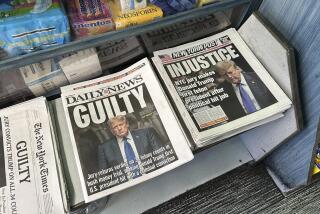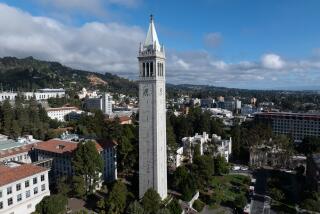Media’s Role in War, Peace Jumps to the Front Burner
- Share via
NEW YORK — On the theory that for most Americans, the media are the sole source of information on issues related to war, peace and the nuclear arms build-up, the Carnegie Corp. and New York University have announced the establishment of the nation’s first research program to examine the role of the media in East-West relations.
Funded by an initial $250,000 grant from the Carnegie Corp. and housed in NYU’s Department of Journalism and Mass Communications, the new Center for War, Peace and the Media will seek to monitor--and thereby, it hopes, to upgrade--coverage of international conflicts and the arms race.
Project Seen as Unique
Carnegie Corp. Executive Vice President David Robinson said the decision to finance the new center was made under the aegis of Carnegie’s three-year-old “Avoiding Nuclear War” program.
“No other project involves studying the media as part of the problem as far as the arms race is concerned--and presumably part of the solution,” said Ann Marie Cunningham, one of three principal organizers of the new center at NYU.
“The idea,” she said, “is that the public gets its picture of the arms race from the press, so examining how the press covers it is crucial to improving public perceptions.”
Such an effort, NYU President John Brademas said, is “vital to scholars, journalists, indeed, I think, to the people of the United States in general,” particularly as a means of “building some structure among the nations of the world to prevent war and encourage peace.”
The new NYU program, announced last week, Brademas said, is “a project that recognizes the power of the media to form public opinion and to seek better to understand the connection between that opinion and the formation of public policy, especially in issues of war and peace.”
“What the news media print or broadcast matters,” said NYU journalism professor David Rubin, a First Amendment scholar and “godfather” of the new program. “That is a potentially difficult statement to trumpet about, because you are talking about questions that relate to the power of the press, and therefore to questions of power and control and accountability, which make people very nervous.
“Occasionally,” Rubin said, “I think even journalists try to deny how much power they have.”
As examples, Rubin cited the “decades-long debate” on the impact of television violence on children, or the “ongoing questions since the fall of Saigon” of the power of the press in Vietnam.
Although, Rubin conceded, “the performance of the press probably does not matter as much as, let us say, the President or the Soviet leaders,” the press remains nonetheless “a player in this game, an important player, and as such, we think it needs to be examined.”
“The notion,” Cunningham elaborated, “is that the press really has not maintained an adversary relationship with the government . . .” but has in fact “been the handmaiden” of government in instances that have had profound ramifications in terms of public opinion and, perhaps, public policy.
“For example,” Cunningham said, quoting from a report by Robert Karl Manoff presented at a 1983 conference that helped spark the formation of the new center, “during the Manhattan Project, the War Department--now the Defense Department--hired the chief science correspondent of the New York Times, William L. Laurence, and gave him exclusive access to such events as the Trinity Explosion.” In the course of his duties, Cunningham said, Laurence “went along on the Nagasaki raid--and afterward wrote a series on the development of the bomb leading up to Hiroshima that won a Pulitzer Prize in 1946.”
Rubin said the project would split its focus equally between research, education and “public outreach,” including the establishment of an awards program to recognize outstanding work in the coverage of war and peace.
Ultimately, Rubin said, the goal of the new center is “to make the American public more knowledgeable about nuclear arms strategy and about public policy.”
More to Read
Sign up for Essential California
The most important California stories and recommendations in your inbox every morning.
You may occasionally receive promotional content from the Los Angeles Times.










